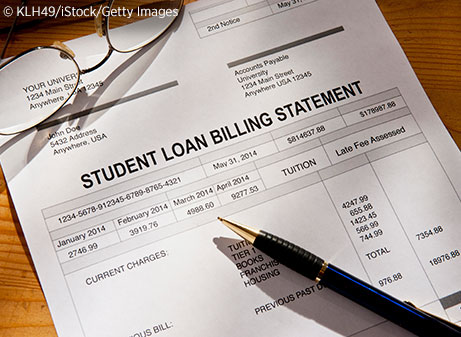Debt Developments in the Eighth District during First Half of 2019
KEY TAKEAWAYS
- Inflation-adjusted debt levels in the U.S. and Eighth District nearly returned to their Great Recession peaks over the first half of 2019.
- Student debt generally grew faster in the U.S. and Eighth District than any other debt category.
- Among the District’s four largest metro areas, the delinquency rates of student loans and auto debt are historically high.

The Great Recession taught us that developments in household debt markets need to be monitored. In previous Regional Economist articles, we have done so by examining auto, consumer credit card, mortgage and home equity line of credit (HELOC) debt using developments observed in the Federal Reserve Bank of New York’s Consumer Credit Panel (CCP).The Federal Reserve Bank of New York’s Consumer Credit Panel (CCP) is based on an anonymized 5% sample of credit files for the U.S. economy, provided by the credit monitoring company Equifax. In this article, all CCP data were adjusted for inflation using the personal consumption expenditures chain-type price index.
This present article complements that work by reporting on updated CCP data for the first half of 2019. In doing so, we consider an additional category of debt that has recently garnered significant attention: student loans. An important new finding will be the rise in 90-day delinquency rates for auto debt across key Eighth District metro areas.
Debt Developments in the First Half of 2019
Since 2013, total household debt has steadily increased in both the U.S. and the Eighth Federal Reserve District.Headquartered in St. Louis, the Eighth Federal Reserve District includes all of Arkansas and parts of Illinois, Indiana, Kentucky, Mississippi, Missouri and Tennessee. In fact, midyear debt levels in 2019 for these two areas were at 92.8% and 99.5%, respectively, of their peak levels during the Great Recession.
| United States | Eighth District | |||||||
|---|---|---|---|---|---|---|---|---|
| Year-over-Year Percentage Change | 90-Day Delinquency Rate | Year-over-Year Percentage Change | 90-Day Delinquency Rate | |||||
| 2019:Q1 | 2019:Q2 | 2010:Q1 | 2019:Q2 | 2019:Q1 | 2019:Q2 | 2010:Q1 | 2019:Q2 | |
| Auto | 2.93% | 3.07% | 4.59% | 4.28% | 2.51% | 2.19% | 3.98% | 4.45% |
| Credit Card | 2.80% | 3.44% | 12.76% | 7.84% | 1.99% | 2.26% | 10.98% | 7.56% |
| Home Equity Line of Credit | –9.32% | –8.78% | 3.36% | 1.08% | –8.84% | –6.46% | 1.13% | 0.63% |
| Mortgage | 1.29% | 2.53% | 7.68% | 0.79% | 0.82% | 2.48% | 3.77% | 0.71% |
| Student Loans | 4.41% | 4.07% | 8.73% | 11.18% | 3.59% | 2.77% | 9.39% | 13.87% |
| Total (Including Student Loans) | 1.59% | 2.47% | 1.32% | 2.20% | ||||
| SOURCES: Federal Reserve Bank of New York/Equifax Consumer Credit Panel and authors’ calculations. | ||||||||
| NOTES: Debt data were adjusted for inflation using the personal consumption expenditures chain-type price index; data as of Aug. 13, 2019. | ||||||||
Table 1 focuses on the data by type of debt for the first and second quarters of 2019 as well as the first quarter of 2010; this 2010 reference corresponds to the peak of mortgage delinquency in our sample.
During the first half of 2019, auto and credit card debt grew in the range of 2% to 4% in all cases, with both the U.S. and Eighth District experiencing slight upticks in credit card debt accrual from the first quarter to the second.
Mortgage debt accrual saw stronger increases over this time frame, which is significant given that it represents the largest portion of household debt. HELOC debt has continued its declining trend.
Student debt consistently increased in the U.S. and Eighth District more than any other debt category. It is interesting to note, however, that the Eighth District was taking on student loans at a slower rate compared with the nation over the first half of 2019.
Eighth District MSA Developments
From a business perspective, recent household debt developments in a metropolitan statistical area (MSA) are likely to be more useful. In this section, we use the recorded ZIP codes in CCP reports to identify household debt developments in the Little Rock, Ark.; Louisville, Ky.; Memphis, Tenn.; and St. Louis MSAs. The resulting data for the first two quarters of 2019 are presented in Table 2.
Three things stand out. First, Louisville was the only MSA we tracked with a growth rate in auto debt that was higher than the national average in the second quarter. This is not a new development; auto debt growth rates in Louisville have been above the national average each quarter for the past three years.
Second, all four areas showed stronger growth in mortgage debt in the second quarter of 2019 than in the first, mirroring the national trend.
Finally, the year-to-year growth in student loans is again generally higher than other categories of debt presented in Table 2 for each area and quarter. The biggest exception to this statement is St. Louis, where the growth rates have slowed somewhat. The largest increases in student debt occurred in the Memphis area.
What is the Message from Delinquency Rates?
So long as debtors continue to repay their debt, an increase in any debt category does not necessarily signal a problem. One way to measure this ability to repay is to examine 90-day delinquency ratesThe 90-day delinquency rate is found by dividing the volume of loan payments 90 or more days past due by the volume of loan payments. in the first two quarters of 2019 and compare them with those in the first quarter of 2010.
| Metropolitan Statistical Area | Debt Type | Year-over-Year Percentage Change in Debt | 90-Day Delinquency Rate | |||
|---|---|---|---|---|---|---|
| 2019:Q1 | 2019:Q2 | 2019:Q1 | 2019:Q2 | 2010:Q1 | ||
| Little Rock, Ark. | Mortgage | –0.83% | 1.37% | 0.78% | 0.69% | 3.14% |
| Home Equity Line of Credit | –2.70% | 2.00% | 0.56% | 0.54% | 1.34% | |
| Auto | –0.84% | 0.28% | 6.04% | 5.83% | 3.75% | |
| Credit Card | –0.62% | 1.21% | 9.03% | 8.95% | 10.28% | |
| Student | 3.56% | 2.11% | 14.49% | 14.21% | 10.66% | |
| Louisville, Ky. | Mortgage | –2.40% | 2.54% | 0.98% | 0.76% | 4.13% |
| Home Equity Line of Credit | –17.77% | –5.70% | 1.03% | 0.77% | 0.77% | |
| Auto | 4.21% | 4.68% | 4.28% | 4.27% | 3.20% | |
| Credit Card | 2.03% | 2.32% | 6.16% | 6.16% | 9.79% | |
| Student | 4.70% | 3.79% | 14.23% | 12.81% | 7.90% | |
| Memphis, Tenn. | Mortgage | –0.44% | 0.96% | 1.23% | 0.93% | 5.74% |
| Home Equity Line of Credit | –11.45% | –10.26% | 0.39% | 0.47% | 0.94% | |
| Auto | 2.47% | 2.70% | 6.75% | 6.68% | 6.62% | |
| Credit Card | 4.88% | 5.75% | 8.61% | 8.36% | 12.75% | |
| Student | 6.10% | 4.42% | 14.34% | 14.19% | 11.71% | |
| St. Louis | Mortgage | 1.63% | 3.30% | 0.69% | 0.63% | 3.81% |
| Home Equity Line of Credit | –12.41% | –11.45% | 0.87% | 0.83% | 1.40% | |
| Auto | 3.28% | 2.42% | 3.73% | 3.71% | 3.31% | |
| Credit Card | 2.35% | 2.94% | 6.64% | 6.44% | 10.30% | |
| Student | 2.06% | 2.19% | 12.36% | 12.41% | 7.97% | |
| SOURCES: Federal Reserve Bank of New York/Equifax Consumer Credit Panel and authors’ calculations. | ||||||
| NOTES: Debt data were adjusted for inflation using the personal consumption expenditures chain-type price index; data as of Aug. 13, 2019. | ||||||
In Table 2, mortgage delinquency rates at the peak ranged from 3% to 6%. The second-quarter mortgage delinquency rates have not exceeded 1% in any of the four MSAs, however. In stark contrast, delinquency rates for auto debt have surpassed the reference rate and prior historical data in every MSA for each of the last two quarters. More importantly, auto debt levels are still increasing in most of these MSAs.
Credit card debt has also been on the rise in the Eighth District. However, the corresponding delinquency rates do not raise as much concern. Even with a slight increase in credit card delinquency rates across the District since 2014, these rates remain low compared with our 2010 reference point and prior historical data.
Lastly, student debt delinquency rates have been on the rise for a number of years. In the second quarter of 2019, Table 2 indicates that the 90-day delinquency rates on student debt ranged from 12.41% in St. Louis to 14.21% in Little Rock. These rates are substantially higher than the rates observed in the first quarter of 2010 and earlier, especially for St. Louis.In the third quarter of 2011, the CCP began changing the way it reported student loans, and we noticed a seemingly discontinuous increase in student loan delinquency rates thereafter, which lasted through the end of 2012. Even if we subtract away the increases that occurred during that time from current delinquency levels, however, the present delinquency rates are still higher for student loans in every MSA but Memphis, which is approximately at the 2010 reference level. Note also that student loans are unique among the types of debt we track because the government is often directly facilitating the loan, so in this case the Great Recession does not provide as clear a precedent for how a debt crisis might unravel.
Endnotes
- The Federal Reserve Bank of New York’s Consumer Credit Panel (CCP) is based on an anonymized 5% sample of credit files for the U.S. economy, provided by the credit monitoring company Equifax. In this article, all CCP data were adjusted for inflation using the personal consumption expenditures chain-type price index.
- Headquartered in St. Louis, the Eighth Federal Reserve District includes all of Arkansas and parts of Illinois, Indiana, Kentucky, Mississippi, Missouri and Tennessee.
- The 90-day delinquency rate is found by dividing the volume of loan payments 90 or more days past due by the volume of loan payments.
- In the third quarter of 2011, the CCP began changing the way it reported student loans, and we noticed a seemingly discontinuous increase in student loan delinquency rates thereafter, which lasted through the end of 2012. Even if we subtract away the increases that occurred during that time from current delinquency levels, however, the present delinquency rates are still higher for student loans in every MSA but Memphis, which is approximately at the 2010 reference level. Note also that student loans are unique among the types of debt we track because the government is often directly facilitating the loan, so in this case the Great Recession does not provide as clear a precedent for how a debt crisis might unravel.
Views expressed in Regional Economist are not necessarily those of the St. Louis Fed or Federal Reserve System.
For the latest insights from our economists and other St. Louis Fed experts, visit On the Economy and subscribe.
Email Us



